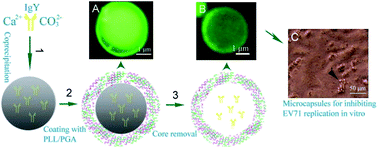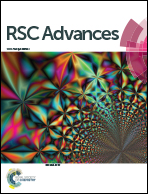Encapsulation of EV71-specific IgY antibodies by multilayer polypeptide microcapsules and its sustained release for inhibiting enterovirus 71 replication
Abstract
To save egg yolk immunoglobulin (IgY) from damage by protease digestion in oral delivery, IgY specific to enterovirus 71 (EV71) was loaded into polypeptide microcapsules by the method of layer-by-layer encapsulation. Porous CaCO3 particles doped with IgY were used as templates which were coated with multilayer poly (L-lysine) (PLL) and poly (L-glutamic acid) (PGA). Then, IgY-loaded polypeptide microcapsules were fabricated after the removal of CaCO3 templates. The alternating adsorption was confirmed by the zeta potential and the successful formation of a multilayer polypeptide (PLL/PGA) shell was visualized by SEM. The influence of the PLL/PGA layer numbers on the IgY sustained release performance was studied in simulated gastric fluid. IgY release could be accurately controlled by adjusting the layer number of the polypeptide shells and only 45% of the IgY was released from 5-bilayer microcapsules in the initial 2 hours. The biological activity of the encapsulated IgY was investigated both in vitro and in vivo. Encapsulated EV71-specific IgY remained highly active and capable of neutralizing EV71 after multilayer polypeptide encapsulation, which provided a promising method to protect EV71-specific IgY in the gastric environment and to specifically release IgY at the target intestinal site for the prevention and control of EV71 infectious diseases.


 Please wait while we load your content...
Please wait while we load your content...